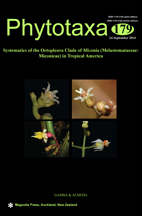Abstract
The Octopleura clade of Miconia is a natural group of Neotropical subshrubs and small trees comprising some thirty-three species. These had previously been described in Ossaea and Clidemia, two traditionally recognized genera of Miconieae, but this natural group is nested within the megadiverse genus Miconia. This study represents the first comprehensive monograph of the clade across its entire range based on a study of over 2100 collections from seven herbaria. Thirteen new combinations are made (Miconia aguilarii, M. aurantiaca, M. biolleyana, M. boekei, M. chocoensis, M. evanescens, M. incerta, M. laxivenula, M. palenquensis, M. quinquenervia, M. radicans, M. reitziana, and M. rufibarbis). Thirteen new names are provided for epithets preempted in Miconia (M. albertobrenesii, M. alboglandulosa, M. approximata, M. atropurpurea, M. bensparrei, M. bractiflora, M. erikasplundii, M. magnifolia, M. neocoronata, M. quadridomius, M. sessilis, M. spiciformis, and M. variabilis). Six new species are proposed (M. alatissima, M. anchicayensis, M. formicaria, M. latidecurrens, M. renatoi, and M. veraguensis). A taxonomic key, detailed descriptions, distribution maps, and phenological and ecological information are presented for all species, along with SEM images of seed morphology for selected species. A preliminary geospatial conservation assessment is made for each species. Diagnostic illustrations are included for all new taxa and other selected species. A molecular phylogenetic analysis based on four genic loci is presented, along with a reconstruction of ancestral character states. Molecular and morphological data are used to develop a better understanding of the constituent species of the clade and their evolutionary relationships. Three subclades, Approximata, Quinquenervia, and Variabilis, are evident within the Octopleura clade, and supported by morphological synapomorphies.

